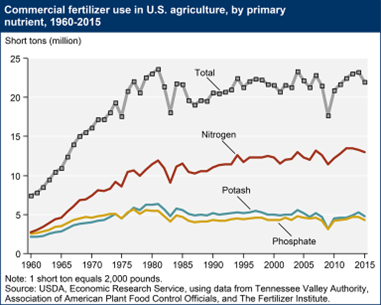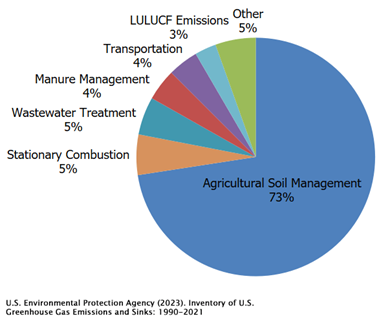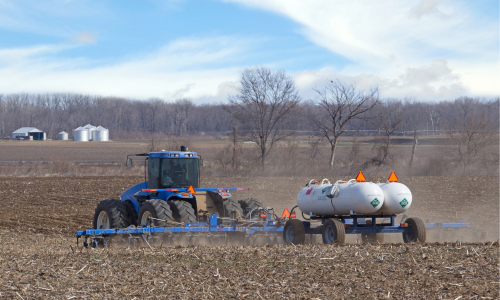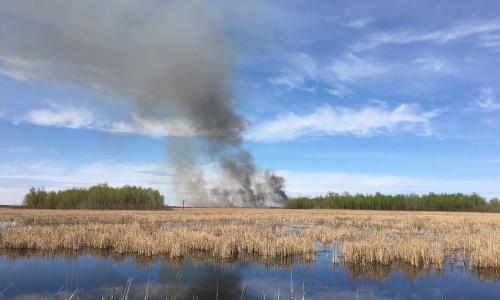Table of Contents
Without the nutrients that fertilizers provide to crops, we would not be able to grow our food. But one of the hallmarks of the US agriculture system today is a massive overapplication of synthetic fertilizer to our soils—far more than crops can actually use.
Much of that unused fertilizer pollutes our air, water, and climate. The giant chemical companies that make and sell all that fertilizer maximize their profits by keeping farmers hooked on their products at the expense of our environment and vulnerable communities.
Chemical fertilizer is big business
The mineral nutrients that plants need most are nitrogen, phosphorus, and potassium. In ecosystems like forests and grasslands, plants get these nutrients as part of a natural cycle. Animals excrete nitrogen in their manure and urine, and together with the breakdown of dead and decomposing plants, these nutrients are incorporated into the soil for the next growing season. Many farmers and gardeners mimic this natural cycle when they apply manure and compost as fertilizer, or when they raise crops and livestock together. But the vast majority of agricultural production in the United States today is fueled by synthetic fertilizers—products of dirty industries and polluting factories.
Phosphorus- and potassium-based fertilizers are made from mined minerals, while nitrogen fertilizer is manufactured using fossil gas based on a century-old method that originally produced nitrogen for use in explosives such as TNT. After World War II, nitrogen production turned to civilian purposes and the fertilizer industry was born. Synthetic fertilizer use per acre of farmland in the United States skyrocketed after 1960, reaching a peak in 1981. Nitrogen fertilizer use has continued to climb according to sales data, with major commodity crops such as corn using the largest share.

At the same time, decades of deregulation have allowed some of the largest food and agriculture companies to consolidate their power. Four meat processors, for example, now control 85 percent of the beef market. The nitrogen fertilizer industry is similarly consolidated: the number of companies in that sector has shrunk dramatically since the 1980s, and just four companies control 75 percent of the market today.
This situation is not good for farmers, who have been hurt by rising fertilizer prices that have resulted from Russia’s position as the leading fertilizer exporter and its war against Ukraine. Meanwhile, large fertilizer companies in the West are growing fast and making a killing. Take CF Industries: this little-known company based in Illinois earned a reported $3.2 billion in 2022, a 10-fold increase in just two years.
Fertilizer overuse damages soil and pollutes our water and communities
The fertilizer industry has succeeded by convincing farmers that its products are needed to increase and maintain crop yields. While it is true that the widespread introduction of synthetic fertilizers after World War II dramatically increased yields, that productivity has come at a steep cost, as long-term overreliance on chemical fertilizers and other industrial farming methods have damaged soils’ natural fertility and structure, creating a vicious cycle in which farmers apply even more chemicals. Much of those chemical nutrients never even reach the plants, instead making their way into our air and water.
Today, scientists estimate that half the nitrogen fertilizer applied worldwide is lost from farm fields rather than taken up by crops. Researchers in 2014 estimated that the United States was responsible for 11 percent of that excess nitrogen. This is more than just wasteful and inefficient—it is a massive source of pollution.
A 2020 UCS report documented how the excess nitrogen that runs off farm fields in the midwestern Corn Belt contaminates waterways and drinking water in the Mississippi River Basin, ultimately reaching the Gulf of Mexico, where it creates a “dead zone” that harms marine life and the region’s economically and culturally important fishing industries. According to our analysis, nitrogen losses from farms upstream have caused up to $2.4 billion in damage to Gulf fisheries and marine habitats every year since 1980.
In addition, the nitrogen and phosphorous in fertilizer runoff feeds algal blooms that threaten bodies of water such as Lake Erie with regularity. Agricultural runoff is the leading cause of water pollution in rivers and streams, the third-leading source in lakes, and the second-largest source in wetlands. What’s more, water quality impacts from fertilizer pollution are getting worse with warmer winters and warmer waters.
The dirty, fossil fuel–based manufacture of fertilizer also creates major environmental justice problems for the predominantly Black and Brown communities where these facilities are often located, such as Louisiana’s infamous “Cancer Alley”—the heavily industrialized stretch of the Mississippi River between Baton Rouge and New Orleans.
Fertilizer has a powerful impact on our climate
The fertilizer industry is responsible for an estimated 5 percent of global heat-trapping emissions. Manufacturing fertilizer requires immense energy input, primarily from power plants that burn fossil fuels and emit carbon dioxide (CO2); scientists have even estimated that producing the ammonia needed for fertilizer generates more CO2 than any other industrial chemical reaction. Fertilizer production also releases other heat-trapping gases including nitrous oxide (N2O) and methane (CH₄), which are 265 and 28 times more potent than carbon dioxide, respectively.
But unlike most manufactured products, fertilizers produce far more emissions in their use than in their production. An estimated two-thirds of the industry’s emissions are generated after farmers apply fertilizer in the field, as naturally occurring soil microbes convert excess fertilizer into various compounds including N2O. Mismanagement of both fertilizers and soils is responsible for 75 percent of US N2O emissions.
Some people may associate N2O with a visit to the dentist’s office, where the euphoria-producing “laughing gas” has long been used as a sedative for dental and medical procedures. But N2O is an increasingly serious climate pollutant, accounting for 6 percent of all human-produced heat-trapping gases in the United States in 2021, and agriculture is responsible for more than three-quarters of the US share.
Sources of US nitrous oxide (N2O) emissions, 2021

The relationship between fertilizers and climate change is a complex web of interactions. Emissions from the production and application of fertilizer contribute to a warmer, wetter climate, which affects how farmers use fertilizer—how much they apply, how often, and when in the growing cycle. At the same time, fertilizer overuse and climate change combine to degrade soils, leaving fields more prone to erosion and damaging the living organisms in healthy soils, causing farmers to compensate with ever more fertilizer.
Agroecology and smart public policies can solve our fertilizer problem
The scale of our fertilizer problem is vast, but so is the potential and opportunity to fix it. Researchers in 2021 mapped 20 excess nitrogen fertilizer “hot spots” across the country. Together, these hot spots—which represent just 24 percent of US agricultural land—contribute more than 2.5 million metric tons of excess nitrogen every year, or 63 percent of the nation’s total. The need for action to reduce fertilizer overuse in these hot spots and in every farming region of the country is urgent.
The science of agroecology, which sees farms as ecosystems rather than factories, offers proven solutions. Unlike industrial farming methods such as monoculture (planting the same crops in the same fields year after year), frequent soil tilling that degrades soil health, and oversaturating the land with polluting chemical fertilizers, agroecology emphasizes sustainable farming practices that do not harm the environment. These practices—which include expanded crop rotations, planting cover crops that protect and replenish the soil, and reducing or eliminating soil tillage—promote healthy soil that naturally supports healthy crops and decreases demand for fertilizer. But healthy soil does more than just reduce fertilizer demand; it also prevents erosion, filters and detoxifies pollutants, and holds water like a sponge.
UCS science and advocacy have made a solid case for federal farm policies that do more to move agriculture in this direction. The next farm bill—or more appropriately, the next food and farm bill—represents a singular opportunity to create a food and farming system that is more sustainable, resilient, healthy, and equitable. The food and farm bill can invest more heavily in the future of our food system with research, technical assistance, and incentives that enable farmers to shift away from massive fertilizer application and other harmful practices.
The Inflation Reduction Act of 2022 made historic investments in helping US agriculture become part of the climate solution while simultaneously becoming more resilient to climate impacts including more frequent and intense droughts and floods. These investments boost funding for a variety of existing USDA conservation programs that underwrite the costs farmers can incur when they adopt soil-protecting, pollution-reducing, climate-friendly practices. The food and farm bill can build on this by incorporating bills like the Agriculture Resilience Act, which would invest in farmers’ ability to promote soil health and thrive in the face of climate change.




